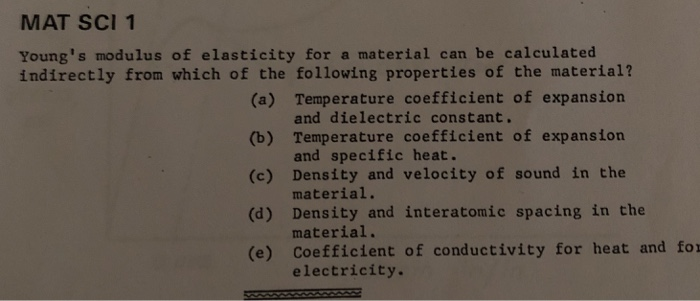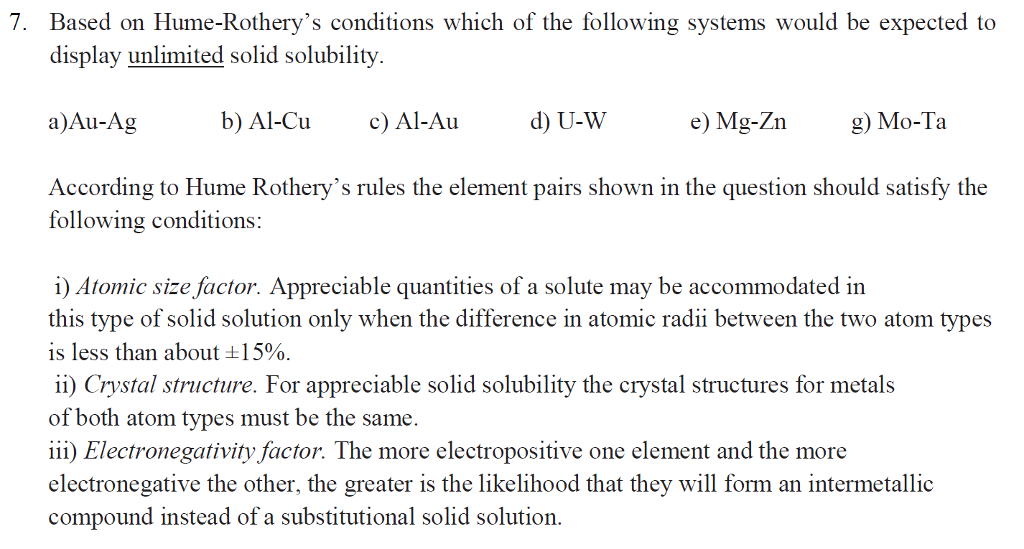Based on Hume-rothery's Conditions Which of the Following Systems
List of Hume-Rothery rules. One refers to substitutional solid solutions and the.

Solved 1 Based On Hume Rothery S Conditions Which Of The Chegg Com
Answer to Marijona meets with her insurance agent Herkus to open a Tax-Free Savings Account TFSA.

. To eliminate the transition from one phase to another phase the materials should have the same crystal structure. Answer to Based on Hume-Rotherys conditions which of the following systems would be expected to display unlimited solid solubility. Test review Chapter 33 The urinary system.
Briefly state the Hume-Rothery rules and explain the rationale 2. Calculate the degree of freedom using Gibbs phase rule. Difference in valence electron size between two materials results in.
Marijona recently retired and in addition to her employer pension p SolutionInn. Hence based on Hume-Rotherys conditions Aluminum Al - Copper Cu do not possess the unlimited solid solubility. Clear handwriting please Question.
934 Based on Hume - Rothery s conditions which of the following systems would be expected to display unlimited solid solubility Explain. Apply the Hume-Rothery rules to determine which following systems would be likely to form unlimited solid solutions. Based on HumeRotherys conditions bartleby.
For copper Cu is 1. The rules are based on differences in the atomic size crystal structure and electron valence state of the solute and solvent. Solution for Based on Hume-Rotherys conditions which of the following systems would be expected to display unlimited solid solu- bility.
These rules are as follow. Based on Hume-Rotherys conditions which of the following systems would be expected to display. Suppose 1 at of the following elements is added to copper forming a separate alloy with.
Based on Hume-Rotherysconditions which of the following systems would be expected to display unlimited soild solubility. Hume - Rothery Rule. A Al-Zn b Cu-Zn c Cu-Sn d Fe-C e Al-Ag.
1 Based on Hume-Rotherys conditions which of the following systems would be expected to display unlimited solid solubility. Based on Hume-Rotherys conditions which of the following systems would be expected to display unlimited solid solubility. Chapter 15 and 16 exam study guide 2.
The size of ions or atoms must be of the similar size and in any case difference between their radius should be greater than 15. A Au Ag b Al Cu c Al Au d U W e Mo Ta f Nb W g Mg Zn h MgCd. Based on the Hume-Rothery conditions which of the following systems would be expected.
Step 1 of 3. MAT SCI 1 Youngs modulus of elasticity for a material can be calculated indirectly from which of the following properties of the material. Conditions that determine whether an alloy or impurity element occupies an interstitial or substitutional lattice site.
Based on Hume-Rotherys conditions which of the following systems would be expected to display unlimited solid solubility. 1 Based on Hume-Rotherys conditions which of the following systems would be expected to display unlimited solid solubility. Crystal structure of aluminum is FCC.
To reduce the lattice strain the difference in the atomic radii size between the materials should not be more than 15. C A SolutionInn. Cuarta Actividad Materiales Avanzados en Manufactura.
Based on Hume-Rotherysconditions which of the following systems would be expected to display unlimited soild solubility. Based on Hume-Rotherys conditions which of the following systems would be expected to. A Wustite b Chalk c silica d Al 2 O 3 in Cr 2 O 3 solid solution 2.
Based on Hume-Rotherys conditions which of the following systems would be expected to display unlimited solid solubility. B The other triple points describe the equilibrium between two solids and a vapor phase. Briefly state the Hume-Rothery rules and explain the rationale 2.
Hume-Rothery rules named after William Hume-Rothery are a set of basic rules that describe the conditions under which an element could dissolve in a metal forming a solid solution. There are two sets of rules. View Homework Help - questiondocx from ENGINEERIN 06-85-219 at University of Windsor.
For an alloy system to have an unlimited solid solubility Size must be similar with 15 difference in atomic radius Crystal Structure must be the same Valence must be the same or close Electronegativity must be approximately the same. Refer to the selected physical properties of aluminum and copper element for crystal structure. Crystal structure of copper is FCC.
Based on Hume-Rotherys conditions which of the following systems would be expected to display unlimited solid solubility. Based on HumeRotherys conditions which of the following systems would be expected to display unlimited solid solubility. For an alloy system to possess the unlimited solid solubility it must satisfy the few conditions which are known as the Hume-Rothery rules.
Homework 7 Lecture Material homework based on the conditions which of the following systems would be expected to display unlimited solid solubility. Based on Hume-Rotherys conditions which of the following systems would be expected to display unlimited solid. A Au Ag b Al Cu c Al Au d U W e Mo Ta f Nb W g Mg Zn h Mg Cd 2 Determine the phases present the compositions of each phase and the amount of each phase.

Solved 7 Based On Hume Rothery S Conditions Which Of The Chegg Com

Solved Based On Hume Rothery S Conditions Which Of The Chegg Com

Solved 1 Based On Hume Rothery S Conditions Which Of The Chegg Com
No comments for "Based on Hume-rothery's Conditions Which of the Following Systems"
Post a Comment